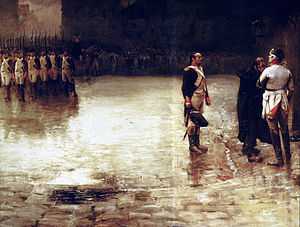François de Charette

François Athanase de Charette de la Contrie (2 May 1763 – 26 March 1796) was a French Royalist soldier, and politician. He was one of the leaders of the bloody events termed the "Revolt in the Vendée". His relative Athanase-Charles-Marie Charette de la Contrie was a noted military leader.
Life
Early activities
A nobleman born in Couffé, arrondissement of Ancenis, Charette served in the French Navy under Toussaint-Guillaume Picquet de la Motte, notably during the American War of Independence, and became lieutenant de vaisseau. He quit the Navy in 1789 and emigrated to Koblenz (Trier) in 1792 (a common move for royalist aristocrats). He soon returned to France to live at his property in La Garnache, and became one of those defending King Louis XVI and Marie Antoinette from physical harm during the mob attack on Tuileries Palace (the Journée du 10 août); arrested in Angers, he was released through the intervention of Charles François Dumouriez.
At some point he became a Freemason,[1]
Insurrection
In 1793, the Revolt in the Vendée against the First French Republic broke out, and the peasant fighters asked Charette to be their leader. He joined Jacques Cathelineau and fought in most of the battles of the Armée catholique et royale. After the parting of the Vendean leaders in September 1793, he and his men retreated. He became the leader of the Lower Vendée, and successfully used guerilla warfare against the Republican troops, even managing to capture a Republican camp in Saint-Christophe-du-Ligneron, near Challans, but ran out of supplies and was decisively attacked by the troops of Nicolas Haxo.

Defeat

On 17 February 1795, near Vertou, Charette signed a peace treaty with the emissaries of the National Convention, which included freedom of religion guarantees and excluded the conscription of local peasants from the levée en masse. The republicans nakedly broke the terms of the treaty, and their parole, going back on the guarantees of religious freedom and began conscripting the peasants once again. They also murdered thousands of royalist prisoners including the Bishop of Dol. Charette and his men returned to the fight again in July and moved to help the planned invasion at Quiberon by emigrated French royalists with assistance from the British Royal Navy.
The Count of Artois, the Bourbon successor to the throne of France, made him Lieutenant General and gave orders to prepare for a royal return which, however, did not eventuate. Charette remained loyal to the old dynasty and the Catholic religion, as did his men and most of the Vendean and Breton peasantry. He, and all the loyal royalists, later refused to join the liberal Orléanists. After the failure of the Quiberon expedition, Charette and his men were pursued by General Lazare Hoche. Charette was wounded but escaped. However he was eventually captured outside La Chabotterie and taken to Nantes for a show trial. He was sentenced to death by a republican kangaroo court and then taken to the town square in procession for a public execution. He was shot by firing squad.[2] A plaque has been erected and still stands upon the place where he was shot. Today memorial ceremonies continue to take place there.
Depictions in films

Charette is a character in the episode The Frogs and the Lobsters of the Hornblower film/television series. Charette is a royalist general in exile who, with the support of the British Royal Navy, attempts and fails to rally the surviving royalists and raise an army in France to restore the king to power.
References
- Anne Bernet, Charette, Perrin, 2005
- Michel de Saint-Pierre, Monsieur de Charette, La Table Ronde, 1977
- George J. Hill, The Story of the War in La Vendée and the Little Chouannerie (New York: D. & J. Sadlier & Co. n.d.)
- The Capture and Death of the Indomitable Charette[1]